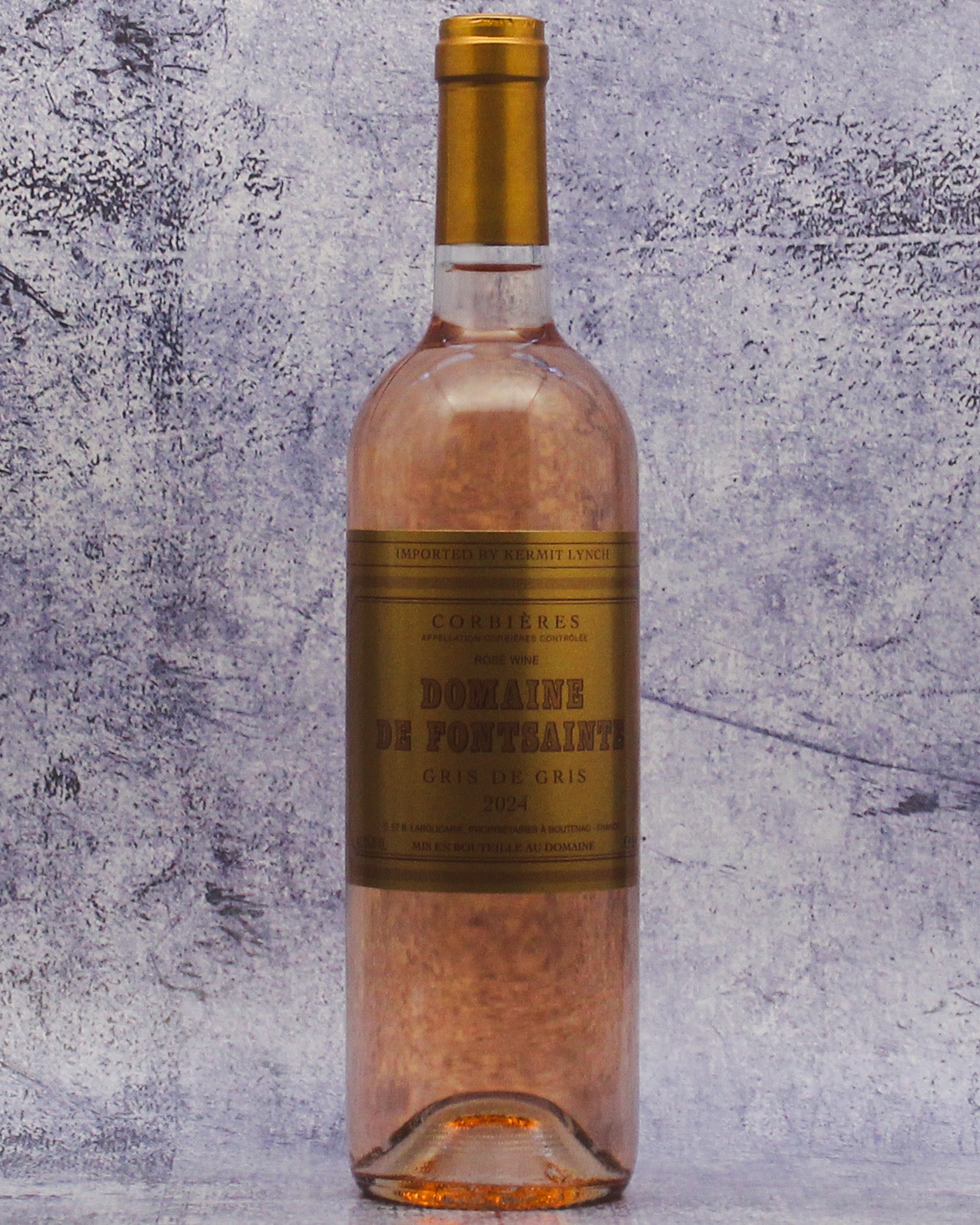From: Languedoc, France
Varietals: 90% Grenache Gris, 5% Carignan, 5% Mourvèdre
2022 vintage. People often wonder, myself included, how Fontsainte’s Gris de Gris can be so good. What sort of sorcery must be involved to consistently offer a wine that is so flawless, so satisfying, and so deliriously value-driven year in and year out?
The domaine’s vineyards happen to be situated in the remote “Golden Crescent” area of Les Corbières. Flanked by a pine forest that protects from harsh winds, this pristine, sun-drenched vignoble benefits from Mediterranean sea breezes and a gravelly soil with large, polished stones that regulate temperature. “In the early morning,” says Bruno Laboucarié, “while the air is still humid, there is this perfume of pine resin and rock roses, of rosemary and thyme, and aromatic heather that warms up above the vineyard.”
Every scent that Bruno describes shows up in the glass, which makes his approach to winegrowing crystal-clear: great wine is made in the vineyard. There are no tricks!
As for the eponymous variety that makes up most of the blend, Grenache Gris is a pink-skinned, more characterful version of Grenache Blanc that ripens into a bouquet of fresh nectarine, white cherries, and bergamot. The pale juice released from gently pressing the grapes immediately after harvest preserves the fruit’s delicate aromas and transforms into a delicious rosé, purely and simply.
Though part of the appeal of Fontsainte’s Gris de Gris is that it’s so drinkable on its own—with just a beach read, or some lawn games to pass the time—its adaptability to food only bolsters its charm. Richer fare is lifted by its juicy acidity, salty foods are washed clean. Try it with crisp cold radishes dipped in soft butter, or brinier foods like cracked crabs, pissaladière, or fresh sardines drizzled in olive oil.
—Jane Augustine
Taste: Expressive and particularly tonic- imagine the , the wine immediately gives off notes of raspberry, white cherry, and freshly picked strawberries - followed by exotic aromas such as pineapple and mango. Aromas of bergamot, sweet basil, and sea-kissed air add freshness and harmony; the 2022 Fontsainte Gris de Gris is a gem indeed. Altogether, this rosé holds a direct and considerable freshness - the density and richness of the fruit mingle with the superb acid vitality giving a wine with a frisson and a magnificent persistency. Stunningly balanced, this is an extremely appealing wine!
Pairing: This wine has a hugely versatile style that will stand up to big flavors such as anchovy, olives, garlic, saffron, and piménton (as well as by itself).
From KLM: More than one objective reporter (two!) has called Domaine Tempier’s rosé the finest rosé in the world. Here, from the Languedoc, is its kid brother.
One warm evening our staff went en masse to Berkeley’s Fourth Street Grill where the roof parts and one dines under an open sky. The Fourth Street Grill is hot right now in more ways than one. The cuisine is great, and some of their dishes are really spicy, providing a challenge to wine lovers who like to match up food and wine.
We started with this Gris de Gris, well chilled, and it was so appropriate we stayed with it until the end, when we polished off a red in order to bring the evening to a logical conclusion.
The Gris de Gris was perfect: freshening, cooling, bone dry, and ideal with everything from spicy shellfish to sausages.
Under everyday conditions it also serves as a sure-fire lead-off batter, preparing one’s palate for a heavy hitter like a Bandol or Châteauneuf-du-Pape rouge.
Its color is like fresh raw salmon. Its aroma has a delicate, fennel-like freshness.
Light in alcohol, delicately-flavored, yet the wine is not weak or thin. It stirs up the appetite.
Hats off to the Domaine de Fontsainte who produced this exquisitely crafted little gem. They continue to provide us with top quality wines at ridiculously low prices.
The wine. The first vineyards at Domaine de Fontsainte, in the Corbières appellation, were planted by the Romans. Artifacts found in these vineyards, such as an old coin dating from the time of Marcus Agrippa in 25 A.D., are a testament to its antiquity. The original domaine was built around a thermal spring, later named for the local, twelfth-century patron saint, Saint Siméon; hence Fontsainte—the saint’s fount. Yves Laboucarié’s family has been making wine here since the seventeenth century.
Like his father, one of the first vignerons working with whole cluster fermentation in the region, Bruno believes strongly in the family’s legacy of innovation. He has re-equipped the cellars, replanted new vines, and even added new cuvées. Frankly, they’ve made no secret as to why they’ve been working with them since 1978, and are quite proud of their long-standing relationship (as they should be; in the wine world, this is a rare partnership indeed).

